As an Amazon Associate KitchenwareSets.com earns from qualifying purchases.
13 Cozy Cottage Kitchen Ideas That Never Go Out of Style
Do you ever walk into your kitchen and feel like something is missing? It’s functional, sure. The appliances work, the counters are clean. But does it have a soul? Does it wrap you in a warm embrace and make you want to linger over a cup of tea on a rainy afternoon?
For many of us, the modern kitchen can feel sterile and impersonal, more like a laboratory for food prep than the true heart of the home. We crave a space that tells a story, a room filled with warmth, character, and the gentle hum of a life well-lived. We’re looking for a kitchen that doesn’t just serve meals, but also serves comfort.
The solution is often found in embracing a timeless aesthetic. A cozy cottage kitchen is a style that prioritizes warmth, charm, and a lived-in feel, blending traditional elements with rustic touches to create an inviting atmosphere. It’s about creating a haven that encourages connection through soft colors, natural materials, and personal collections that make the space uniquely yours.
Dreaming of a Kitchen That Feels Like a Warm Hug?
A cozy cottage kitchen is essentially the embodiment of comfort and nostalgia in home design. Unlike stark, minimalist kitchens that prioritize efficiency above all else, the cottage kitchen is all about feeling. It’s a style rooted in the romantic ideal of a countryside cottage, where life is a little slower and the kitchen is the central hub for gathering, cooking, and making memories.
We’ve spent years analyzing timeless designs, and the cottage kitchen remains a favorite for its ability to instantly feel like home. It’s a forgiving style, celebrating imperfections and a “collected-over-time” look rather than demanding rigid uniformity. This aesthetic is less about following strict rules and more about curating a space that reflects your personality and offers a warm welcome to everyone who enters.
The core principle is to create a functional workspace that doesn’t sacrifice charm. Every element, from the cabinet knobs to the curtains on the window, is chosen to contribute to an overall feeling of warmth and gentle, rustic elegance.
What Makes a Cottage Kitchen So Irresistibly Charming?
The irresistible charm of a cottage kitchen lies in its unique blend of romantic, whimsical elements with practical, rustic simplicity. While often confused with farmhouse style, a cottage kitchen has a distinct personality. Think of it this way: if a farmhouse kitchen is practical and grounded, a cottage kitchen is its slightly more romantic and day-dreamy cousin.
In my experience designing and consulting on kitchen remodels, clarifying this difference is key. A farmhouse kitchen often features more industrial touches, neutral color palettes, and sturdy, practical furniture. A cottage kitchen, on the other hand, embraces a softer, more personal aesthetic.
Here are the key pillars that define the cottage look:
- Color Palette: The foundation is built on soft, muted colors. Think creamy whites, buttery yellows, sage greens, dusty pinks, and powder blues. These colors enhance natural light and create a cheerful, airy environment.
- Materials & Textures: Natural materials are paramount. You’ll find an abundance of wood (often painted or distressed), stone, and wicker. Textiles are soft and natural—linen, cotton, and even lace—often featuring floral or botanical prints.
- Furniture: Furniture tends to be smaller in scale, fitting the cozy “cottage” ideal. It’s often a mix of mismatched vintage pieces, which adds to the eclectic and personalized charm.
- Decorative Elements: This is where the story is told. Open shelves display charming dishware, vintage finds, and handcrafted items. Fresh flowers, botanical prints, and glass-front cabinets showing off pretty teacups are hallmarks of the style.
- Ambiance: Ultimately, it’s about creating a cozy, lived-in feel with a touch of nostalgia. It feels personal, comfortable, and completely unpretentious.
13 Timeless Cozy Cottage Kitchen Ideas for a Charming Makeover
Ready to transform your kitchen from purely functional to wonderfully charming? Here’s the deal: achieving that cozy cottage feel doesn’t require a complete demolition. It’s about layering in specific elements that work together to create a warm and inviting atmosphere. These 13 ideas are curated from hundreds of real-life cottage kitchens, focusing on elements that provide the most impact and timeless appeal. Updated for 2025, these tips will help you create the cottage kitchen of your dreams.
- Embrace a Soft, Muted Color Palette
- Display Your Charm with Open Shelving
- Choose Timeless Cottage-Style Cabinets
- Integrate Warm Wood & Reclaimed Elements
- Install a Quintessential Farmhouse Sink
- Layer Vintage-Inspired Lighting
- Add Cozy Textiles and Fabrics
- Incorporate Vintage Details & Flea Market Finds
- Create a Comfy Seating Nook
- Bring Nature In with Flowers & Botanicals
- Utilize Practical & Pretty Storage
- Lay the Foundation with Hardwood Flooring
- Blend Old and New with Modern Touches
1. Embrace a Soft, Muted Color Palette
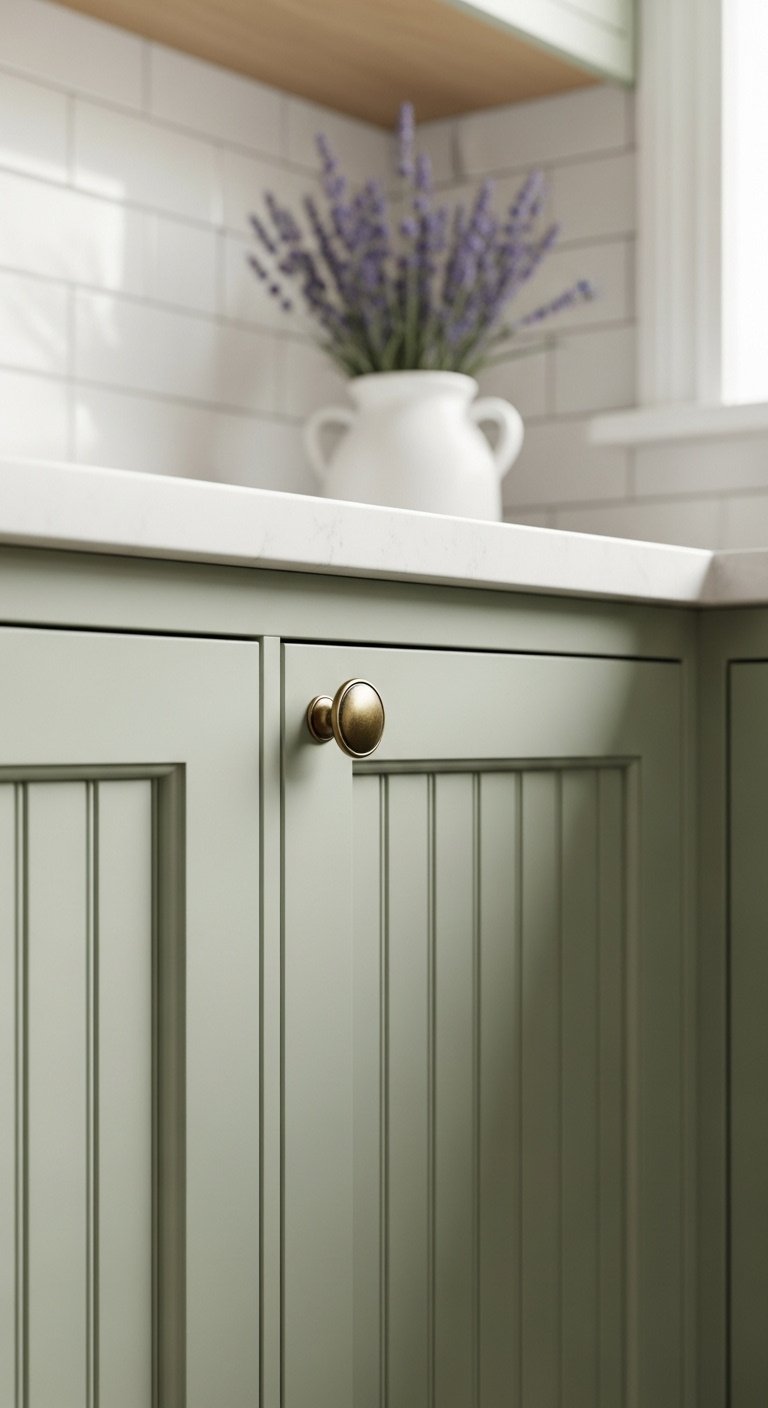
The foundation of any cottage kitchen is its color, which should create a light, airy, and inviting space. Forget stark whites or bold, dramatic hues. This style thrives on a palette of soft whites, warm creams, gentle pastels, and muted earth tones. These colors work beautifully to enhance natural light, making even a small kitchen feel more spacious and welcoming.
Think of colors that you would find in a country garden: the soft green of new leaves, the pale blue of a summer sky, or the dusty rose of a faded bloom. These shades provide a perfect backdrop for the other elements of your cottage design.
- Materials Needed: High-quality interior paint in your chosen color (e.g., creamy white, soft taupe), primer, paint rollers, brushes, painter’s tape, drop cloths.
- Step-by-Step Directions:
- Prep Your Space: Clean all walls and cabinets thoroughly. Protect floors and countertops with drop cloths and apply painter’s tape around trim and edges.
- Apply Primer: If you are making a dramatic color change, applying one coat of a quality primer is a non-negotiable step. Let it dry completely.
- Paint the Walls: Using a roller for the large areas, apply your primary soft color to the walls. Use a brush for “cutting in” around corners and trim. A second coat is almost always necessary for a rich, even finish.
- Paint Cabinets (Optional): For the most impactful transformation, paint your cabinets in a complementary soft hue like a warm white or sage green. This is where the cottage character really comes to life.
Pro Tip: Before committing to a color, I always paint a large swatch on the wall, at least 2×2 feet. Live with it for a few days and observe how the color changes with the natural light throughout the day. A color that looks perfect in the morning might feel completely different in the evening.
Pin this color inspiration for your dream kitchen makeover!
2. Display Your Charm with Open Shelving
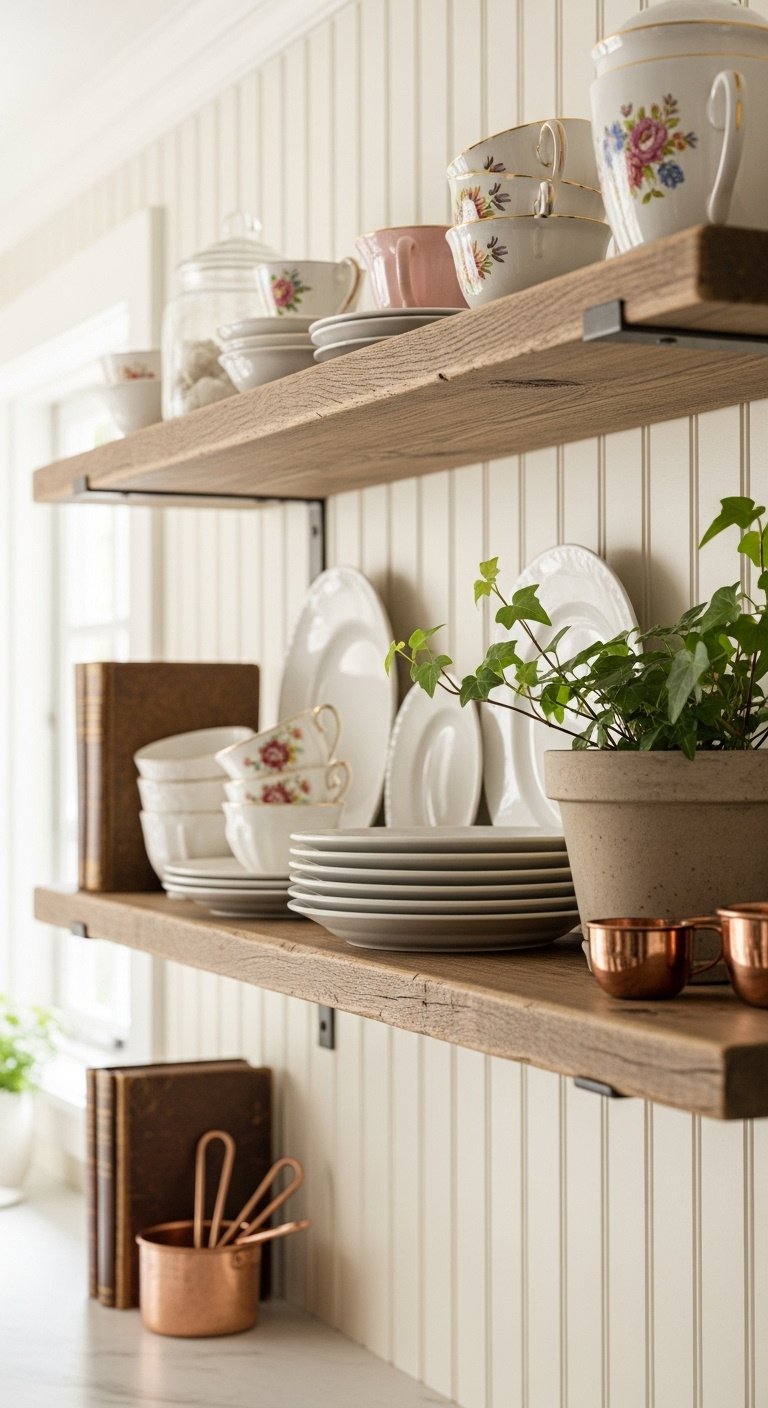
Open shelving is a hallmark of the cottage style because it allows you to display personal collections and add visual interest. This is your chance to turn everyday items into decor. Upper cabinets can sometimes make a small kitchen feel closed-in, but open shelves create a sense of airiness and provide the perfect stage for your favorite dishware, vintage glassware, and treasured cookbooks.
The key is to make it look curated, not cluttered. It’s a space to showcase the things you love, turning practical storage into a charming design feature.
- Materials Needed: Reclaimed wood planks or quality lumber, shelf brackets (e.g., aged brass, wrought iron), a level, a drill, appropriate wall anchors, a tape measure, and sandpaper.
- Step-by-Step Directions:
- Prepare Shelves: Cut your wood planks to the desired length. Sand them until they are smooth and apply a food-safe stain or paint if you wish.
- Mark Your Wall: Use a tape measure and a level to mark exactly where your brackets will go. Precision is key here; ensure they are perfectly aligned.
- Install Brackets: Drill pilot holes and secure the brackets to the wall. For drywall, it is crucial to use wall anchors that can support the weight you plan to put on the shelves.
- Attach Shelves: Place the wood plank on top of the brackets and secure it from underneath with short screws.
- Style Away: Now for the fun part! Arrange your favorite dishes, mugs, and decor items. Mix heights and textures to create a visually appealing display.
Lesson Learned: The biggest mistake I see with open shelving is overcrowding. To prevent a cluttered look, stick to a consistent color palette for about 80% of the items on your shelves (like all-white dishes). Use the other 20% for pops of accent color through mugs, a plant, or a vintage tin.
Save this shelving idea to your ‘Kitchen Storage’ board!
3. Choose Timeless Cottage-Style Cabinets

Cottage-style cabinets are the workhorses of the aesthetic, defined by simple, classic details like Shaker-style or beadboard fronts. These styles have a timeless quality that feels both traditional and charming. Glass-front upper cabinets are another popular choice, as they offer a chance to display pretty glassware while protecting it from dust, combining the openness of shelves with the structure of a cabinet.
The hardware you choose is like the jewelry of your kitchen. Opt for simple knobs and cup pulls in aged finishes like brass, oil-rubbed bronze, or antiqued nickel to complete the vintage-inspired look.
- Materials Needed (for a refresh): Degreasing cleaner, medium-grit sandpaper, high-quality primer, cabinet-specific paint, new hardware (knobs/pulls), and a screwdriver.
- Step-by-Step Directions:
- Remove Hardware: Take off all doors, drawers, knobs, and pulls. Label them so you know where they go back!
- Clean & Sand: This is the most important step for a lasting finish. Thoroughly clean all surfaces with a degreaser. Then, lightly sand the surfaces to rough them up, which helps the primer adhere.
- Prime: Apply a thin, even coat of high-quality primer designed for cabinets. Let it dry completely.
- Paint: Apply two thin coats of your chosen cabinet paint, allowing for adequate drying time between coats as recommended by the manufacturer.
- Install New Hardware: Once the paint is fully cured (this can take a few days!), drill new holes if needed and install your beautiful vintage-style knobs or pulls. Rehang the doors and enjoy your transformed kitchen.
Pro Tip: For a truly authentic cottage look, don’t be afraid to mix and match hardware. From my experience, using cup pulls for drawers and simple round knobs for cabinet doors creates a layered, custom feel that is full of character.
Love this cabinet style? Pin it for your next renovation!
4. Integrate Warm Wood & Reclaimed Elements
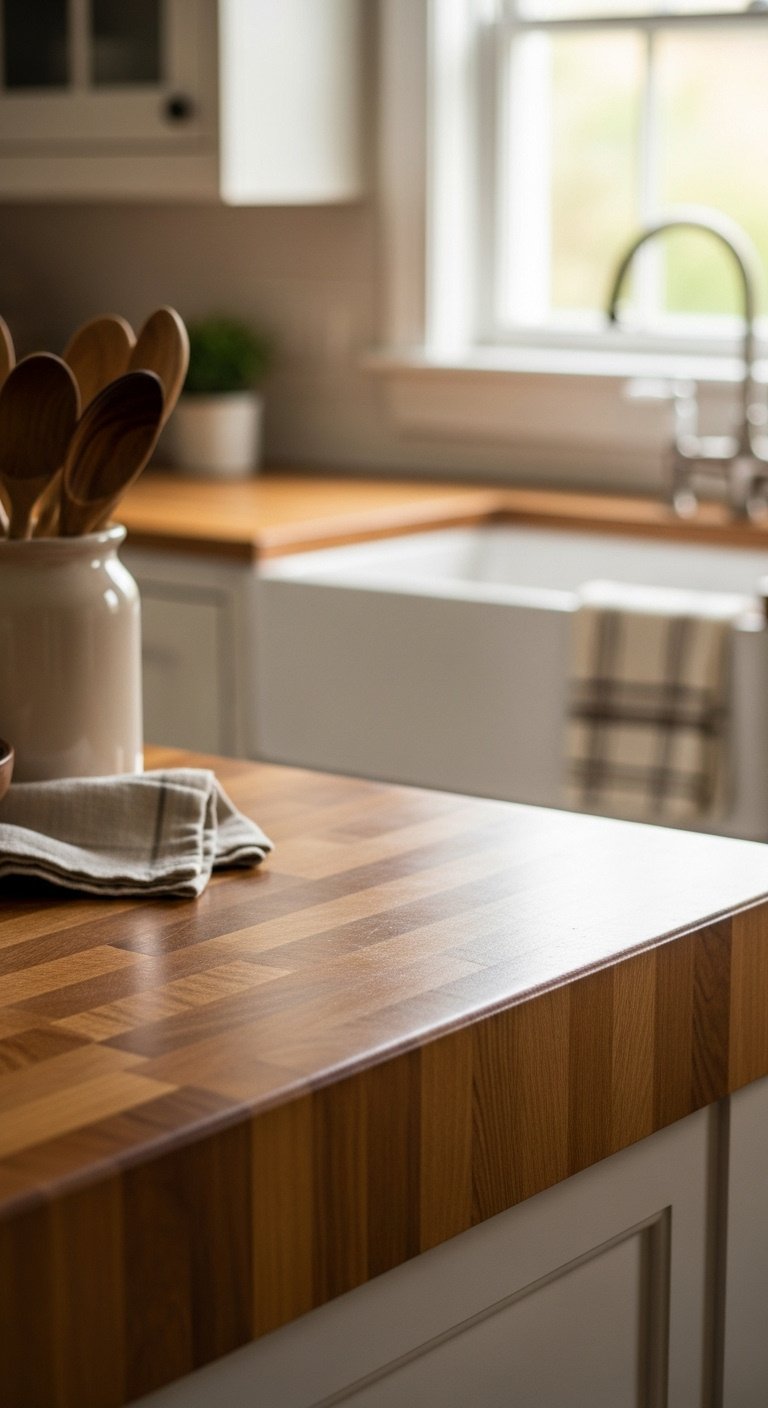
Incorporating warm wood elements is essential for adding natural texture, rustic charm, and a sense of history to a cottage kitchen. Wood instantly makes a space feel warmer and more grounded. Butcher block countertops are a classic choice, offering a durable and beautiful work surface that only looks better with age.
But it doesn’t stop at countertops. Think about reclaimed wood for open shelving, a vintage wooden island, or even accent beams on the ceiling. Small touches like wooden utensils in a crock or a collection of antique cutting boards also contribute to the warm, authentic feel.
- Materials Needed (for Butcher Block Care): Food-safe butcher block conditioner or mineral oil, soft cloths, wooden utensils, wooden cutting boards.
- Step-by-Step Directions (For Butcher Block Care):
- Clean the Surface: Wipe the butcher block with a damp cloth and mild soap, then dry it thoroughly.
- Apply Oil: Pour a generous amount of food-safe mineral oil or a specialized conditioner onto the surface.
- Spread Evenly: Using a clean, soft cloth, rub the oil into the wood, moving in the direction of the grain.
- Let it Soak: Allow the oil to soak in for at least 4-6 hours. In my own kitchen, I do this overnight for the best results.
- Buff Off Excess: Use a clean, dry cloth to buff off any remaining oil from the surface. You should repeat this process monthly to keep the wood hydrated and prevent it from drying out or cracking.
Pro Tip: Don’t limit wood to just the countertops. One of my favorite design tricks is to start a collection of vintage wooden cutting boards in various shapes and sizes. Leaning them against the backsplash behind the stove adds instant warmth and texture with zero installation required.
Add this warm touch to your kitchen design board!
5. Install a Quintessential Farmhouse Sink
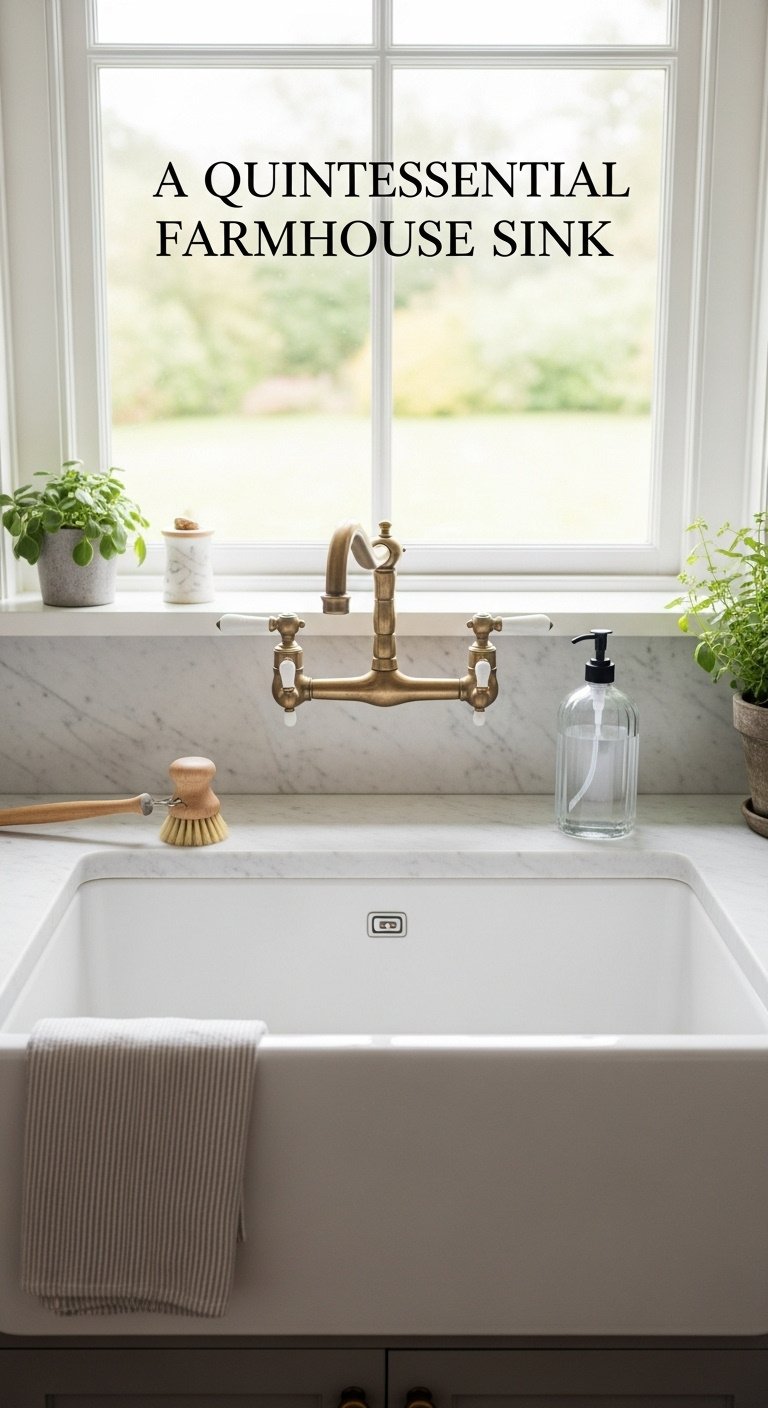
An apron-front farmhouse sink is arguably the single most iconic element of both cottage and farmhouse kitchens. Its deep basin is incredibly practical for washing large pots and pans, while its exposed front adds a substantial, nostalgic touch that instantly grounds the space. These sinks, typically made from durable fireclay or classic cast iron, are a statement piece.
While it’s a significant investment, a farmhouse sink is a timeless feature that defines the cottage aesthetic and adds significant character to the entire room.
- Materials Needed (for styling): A bridge-style faucet, a wooden dish brush, linen tea towels, and a small vase of flowers.
- Step-by-Step Directions:
- Choose the Right Faucet: The faucet is just as important as the sink. Pair your farmhouse sink with a vintage-inspired faucet, such as a gooseneck or a bridge style, in a warm metal finish like aged brass or polished nickel.
- Accessorize Thoughtfully: Keep the area around the sink functional but charming. Decant your hand soap into a pretty ceramic or glass dispenser and swap a plastic scrub brush for a beautiful wooden one.
- Add Softness: A simple linen or floral dish towel casually draped over the front of the sink is a classic cottage styling trick that adds a layer of softness.
- Bring in Life: If your sink is under a window, place a small mason jar or vintage vase with a few fresh-cut flowers or herbs on the windowsill.
Lesson Learned: One critical piece of advice: farmhouse sinks require a special base cabinet that is shorter than standard cabinets to accommodate the sink’s depth and exposed front. When I was planning my first kitchen with one, I learned you must always check the sink’s specific installation requirements before ordering your cabinetry to avoid costly mistakes.
Is a farmhouse sink on your wishlist? Save this for inspiration!
6. Layer Vintage-Inspired Lighting
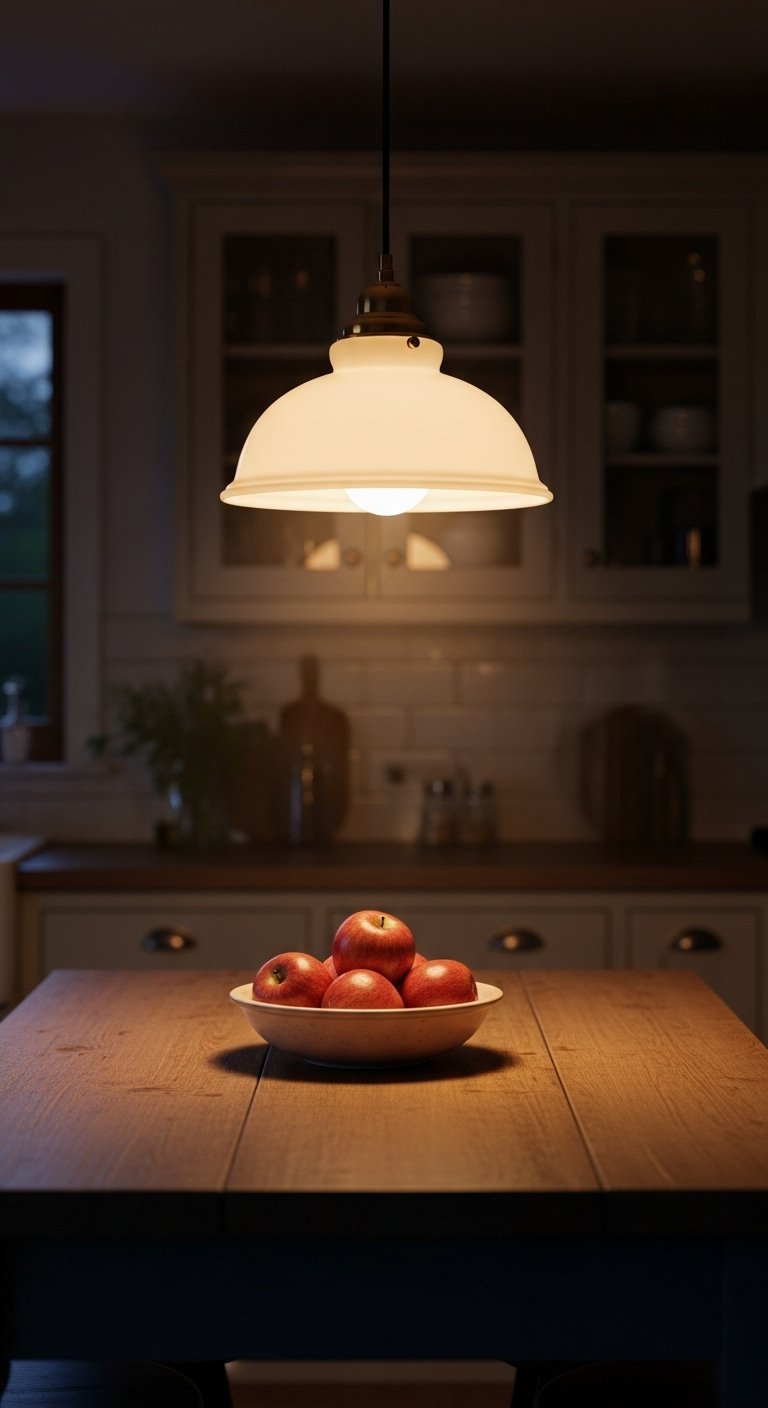
Lighting is crucial for creating ambiance, and in a cottage kitchen, it should be a warm, layered mix of vintage-inspired fixtures. Proper lighting can make a kitchen feel cozy and intimate. Move beyond basic recessed lighting and think in layers: ambient (overall), task (focused), and accent lighting.
A statement pendant light, like a milk glass schoolhouse fixture or a small chandelier with aged metal, makes a perfect focal point over an island or table. Supplement this with wall sconces over the sink or open shelves for focused task lighting that adds a ton of charm.
- Materials Needed: A primary pendant light, secondary task lighting (sconces or under-cabinet lights), dimmer switches, and warm-toned light bulbs.
- Step-by-Step Directions:
- Choose a Focal Point: Hang a statement vintage-style pendant light or a small chandelier over the kitchen island or dining table. This acts as the centerpiece of your lighting scheme.
- Add Task Lighting: Install wall sconces over the sink or flanking open shelving to provide focused light for tasks. Discreet under-cabinet LED strips are another great, modern way to add functional task lighting without detracting from the vintage feel.
- Install Dimmer Switches: This is a game-changer. I tell every client to add dimmer switches to all their light sources. This is the single most important tool for adjusting the mood from bright and functional for cooking to warm and cozy for dining or relaxing.
- Use Warm Bulbs: Choose light bulbs with a warm color temperature (between 2700K and 3000K) to enhance the cozy, inviting feel.
Pro Tip: Don’t be afraid to mix metals in your lighting fixtures. A brass pendant can look absolutely beautiful with oil-rubbed bronze sconces, as long as they share a similar vintage aesthetic or level of formality. This adds to the “collected-over-time” feel.
Light up your kitchen! Pin this cozy lighting idea.
7. Add Cozy Textiles and Fabrics
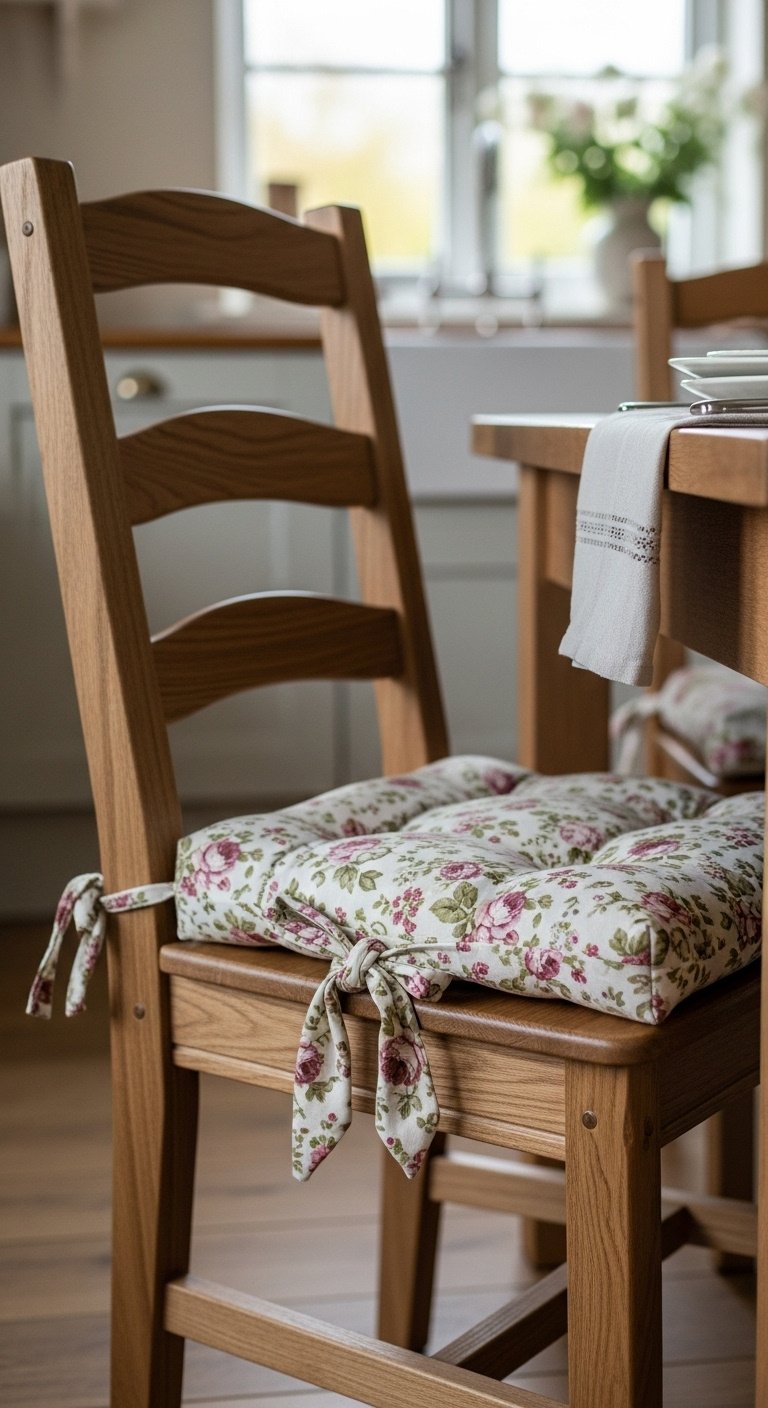
Textiles are a powerful and often overlooked tool for adding softness, color, pattern, and a handcrafted feel to a kitchen. A cottage kitchen without textiles can feel cold and unfinished. Simple additions like curtains, seat cushions, and table linens can completely transform the mood of the space.
Look for natural fabrics like cotton and linen in classic cottage patterns. Florals are a quintessential choice, but gingham, simple stripes, and ticking are also perfect for achieving the look.
- Materials Needed: Cafe curtains, a tension rod, fabric for a tablecloth or runner, and cushioned seat pads for chairs.
- Step-by-Step Directions:
- Soften Windows: Hang simple cafe curtains in a floral or gingham print over the kitchen sink. This is a classic cottage move that adds a touch of privacy and charm without blocking precious natural light.
- Dress the Table: If you have an eat-in kitchen or a small dining nook, use a linen tablecloth or a simple striped runner to add texture and color.
- Cushion Your Seats: Add comfortable cushioned pads, tied on with bows, to hard wooden chairs or bench seating. This is an instant invitation to sit and stay awhile.
- Swap Out Linens: Don’t forget the small things. Use pretty, patterned dish towels and swap out disposable paper towels for a stack of soft, knitted dishcloths.
Pro Tip: A simple way to create a cohesive look with textiles is to follow a simple design rule: choose a primary, more complex pattern (like a multi-colored floral) and a secondary, simpler pattern (like a two-tone stripe or gingham) that pulls colors from the primary pattern. Using these two together creates a layered, professional look.
Save this post for cozy decor inspiration!
8. Incorporate Vintage Details & Flea Market Finds
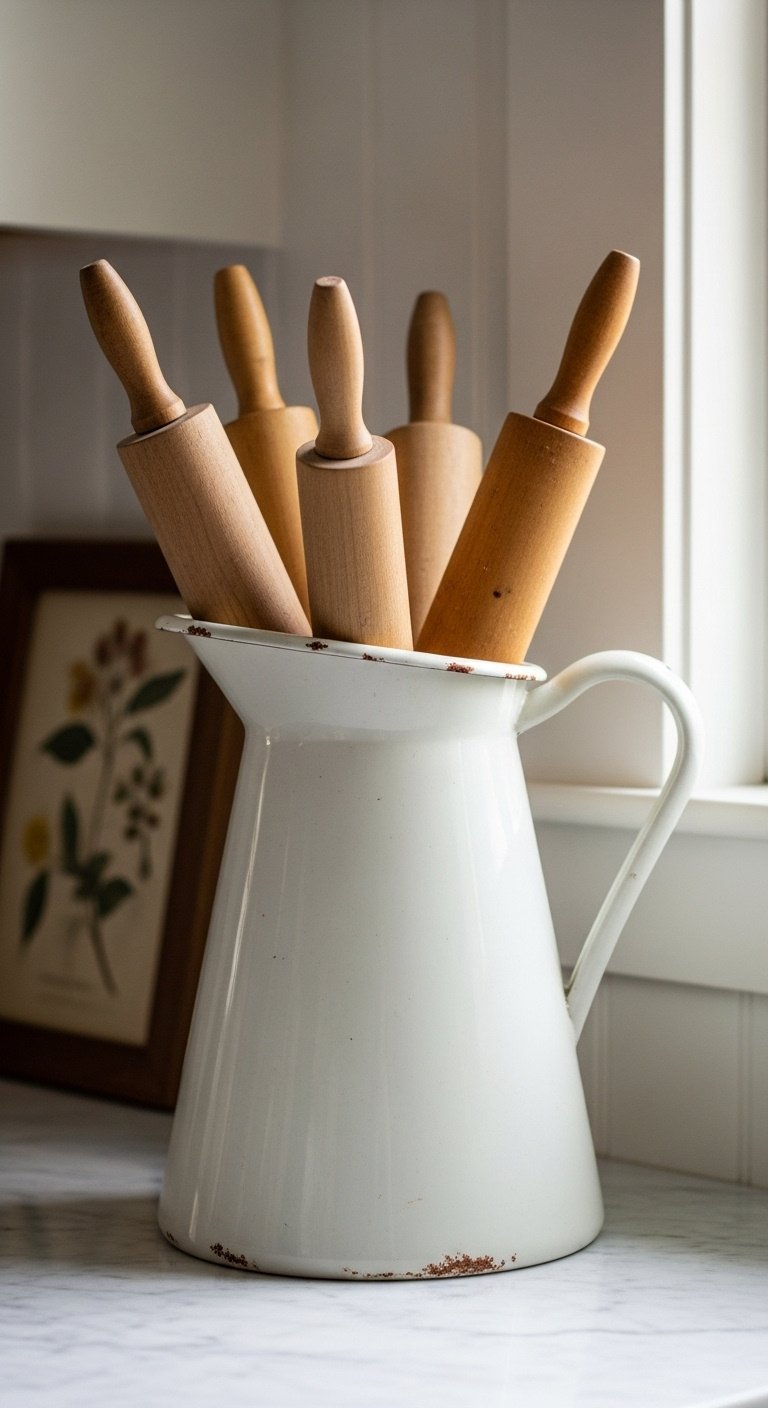
The true soul of a cottage kitchen comes from adding unique character and a sense of history with secondhand items. This is what prevents the style from looking like it came straight out of a catalog. Hunting for treasures at flea markets, antique shops, and even your grandmother’s attic is part of the fun. These pieces tell a story and infuse your kitchen with personality.
Look for antique kitchenware like ironstone pitchers, old food scales, botanical prints, or mismatched floral teacups. Even a single piece of heirloom furniture, like a small stool or cabinet, can become a cherished focal point.
- Materials Needed: A collection of your favorite vintage finds (e.g., ironstone pitchers, old scales, botanical prints, mismatched teacups).
- Step-by-Step Directions:
- Create a Vignette: Group a few related items together on an open shelf or a corner of your countertop. For example, a vintage pitcher filled with old wooden spoons next to a stack of antique cookbooks creates a beautiful, story-rich moment.
- Hang Artwork: Don’t forget the walls! Frame vintage botanical prints, old family recipes, or pastoral landscape paintings and hang them on a small, empty wall for an instant artful touch.
- Use for Storage: Put your finds to work. Use antique crocks to hold utensils, a vintage wire basket to store eggs, or a beautiful old tin to hold tea bags.
- Repurpose Furniture: Think outside the box. A small antique dresser or console table can be repurposed as a charming coffee bar or extra storage for linens and serving pieces.
Lesson Learned: The key to a beautiful “collected” look is careful editing. It’s tempting to display every treasure at once, but this can lead to clutter. In my own home, I rotate my favorite pieces seasonally. This keeps the space feeling fresh and allows each special item to have its moment to shine.
Pin your favorite vintage finds!
9. Create a Comfy Seating Nook
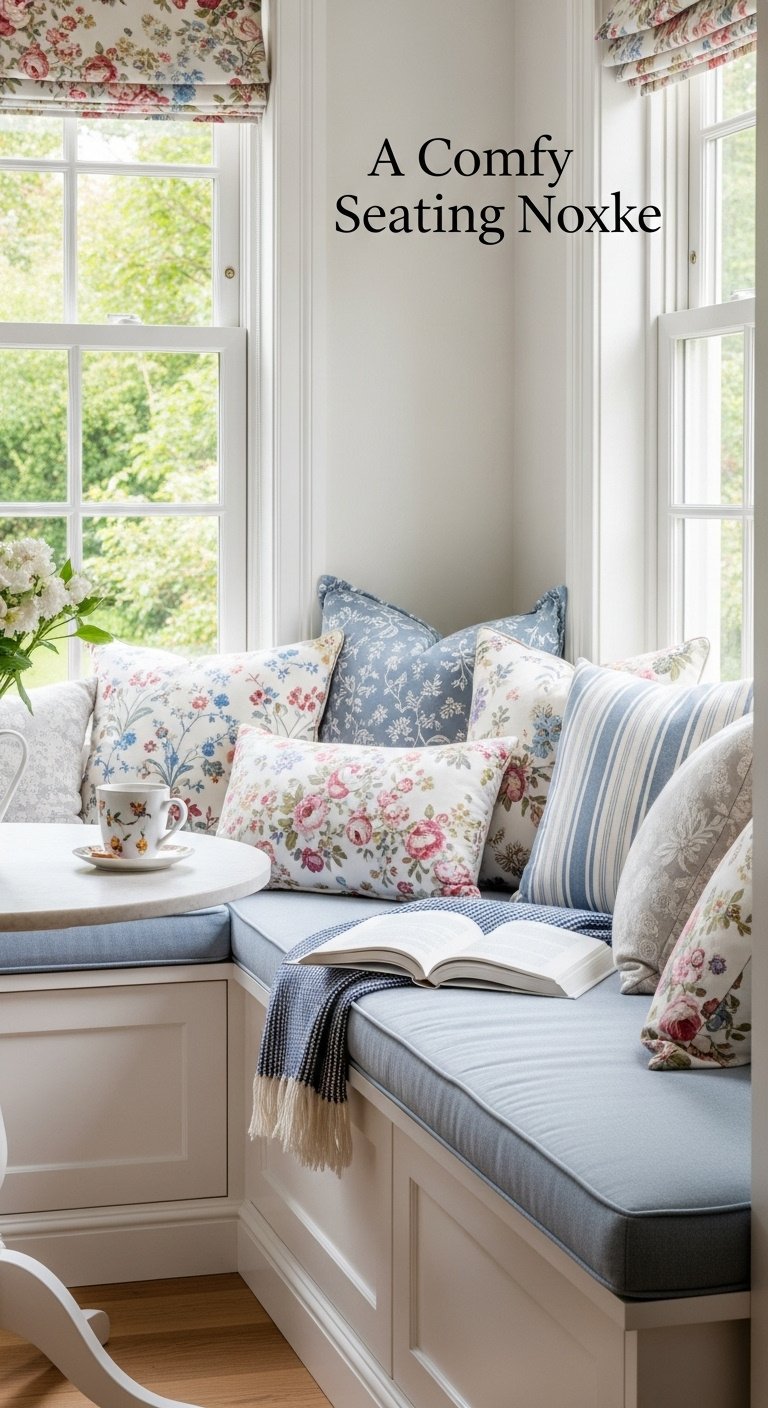
A cottage kitchen is a gathering place, so it’s important to incorporate a comfortable spot for people to sit and connect. Even in a small kitchen, you can usually find a corner to create a cozy seating nook. A built-in window seat is the ultimate cottage dream, offering a sunny spot to read a book with a cup of coffee.
But you don’t need a custom build-out to achieve this. A small upholstered armchair tucked into a corner, a simple bench with pillows against a wall, or a small round table with a couple of chairs can all serve as a charming and comfortable gathering spot.
- Materials Needed: A small bench or armchair, several decorative pillows in various sizes and patterns, and a soft throw blanket.
- Step-by-Step Directions:
- Identify a Spot: Look for an underutilized corner, the space beneath a window, or a small, empty stretch of wall.
- Add Seating: Place a small upholstered armchair or a simple wooden bench in your chosen spot.
- Layer with Pillows: This is key to making it look plush and inviting. Add at least three pillows. Use a mix of patterns (e.g., one floral, one stripe, one solid) that coordinate with your kitchen’s overall color palette.
- Drape a Throw: Casually drape a soft throw blanket—perhaps in a chunky knit or soft cotton—over the back of the chair or the edge of the bench. This adds a final layer of irresistible coziness.
Pro Tip: If you are building a window seat, I highly recommend designing it with a hinged lid on the bench. This creates an incredible amount of valuable hidden storage for bulky, seasonal items or small appliances that you don’t use every day.
Wouldn’t you love to curl up here? Save this cozy idea!
10. Bring Nature In with Flowers & Botanicals
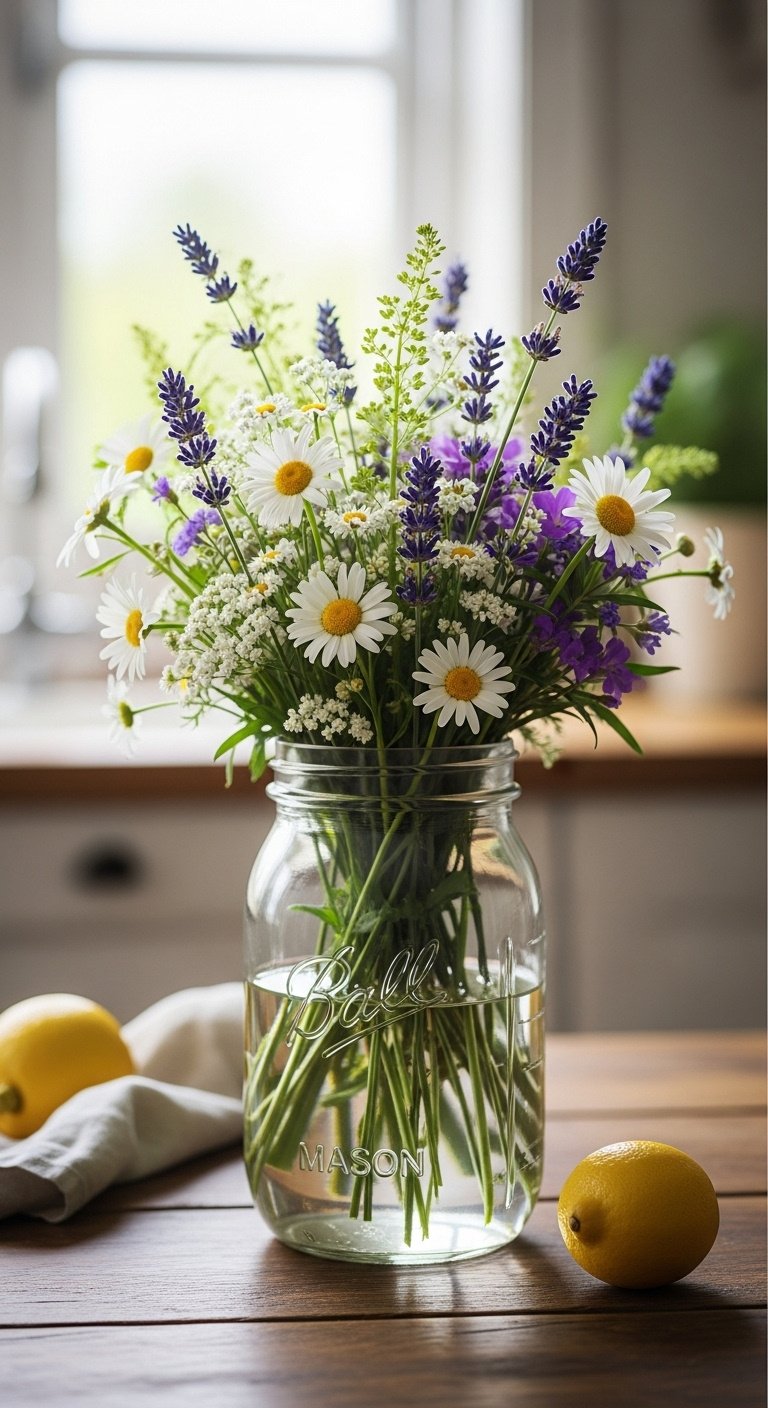
The cottage aesthetic is deeply connected to the idea of the countryside and the garden, so it’s vital to add life, color, and natural beauty with fresh flowers and plants. This is one of the easiest and most affordable ways to make your kitchen feel instantly more charming and alive.
You don’t need elaborate, expensive bouquets. A simple jam jar filled with wildflowers from the garden, a few stems of greenery in a vintage vase, or a small pot of herbs on the windowsill can have a huge impact. Beyond fresh flowers, you can incorporate botanical elements through floral wallpaper, framed prints, or even patterned dish towels.
- Materials Needed: Small terracotta pots, potting soil, herb seedlings (e.g., basil, rosemary, mint), and a vintage vase or mason jar.
- Step-by-Step Directions (For a Windowsill Herb Garden):
- Choose Your Herbs: Select 3-4 of your most-used fresh herbs. Basil, mint, rosemary, and parsley are all great choices.
- Pot the Plants: Fill the bottom of your terracotta pots with a small layer of gravel or pebbles for drainage. Then, add potting soil and your herb seedling.
- Find a Sunny Spot: Place the pots on your sunniest windowsill, preferably the one closest to your cooking area for easy access when you need a fresh sprig.
- Water as Needed: Water your herbs regularly, but be careful not to overdo it. The best rule of thumb is to let the soil dry out slightly between waterings.
Pro Tip: For long-lasting floral beauty, choose flowering potted plants like geraniums, African violets, or small hydrangeas. For cut flowers, nothing captures the cottage spirit better than a simple, informal bouquet of wildflowers or roses fresh from the garden.
Brighten your day! Pin this simple decor idea.
11. Utilize Practical & Pretty Storage
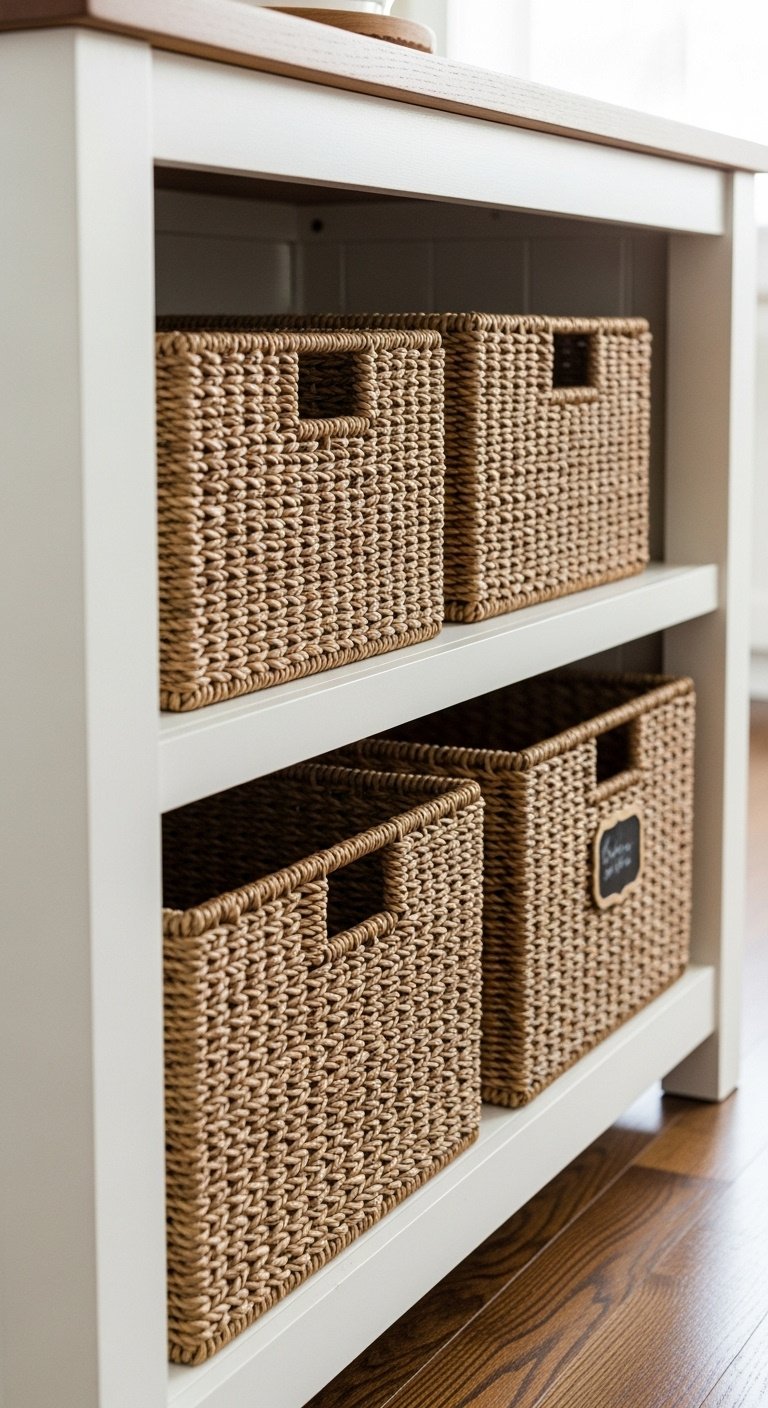
In a cozy cottage kitchen, storage should be both functional and charming, contributing to the overall aesthetic. Beyond cabinets and shelves, think about creative solutions that keep essentials accessible while adding texture and character. A freestanding dresser or hutch can provide a ton of storage and act as a beautiful piece of furniture.
Simple solutions like a wooden peg rail for hanging mugs and aprons, or a collection of wicker baskets for storing linens or root vegetables, are perfect for this style. The goal is to make your storage solutions part of the decor.
- Materials Needed: A wooden peg rail, a drill, a level, your favorite mugs, and small hanging baskets.
- Step-by-Step Directions:
- Choose a Wall: Find a section of empty wall that could be put to better use—perhaps between a doorway and a cabinet or above a countertop where you make coffee.
- Install the Rail: Use a level to ensure the peg rail is perfectly straight. Mark your holes, drill, and securely mount it to the wall, using anchors if needed.
- Hang Your Items: Use the pegs to hang your prettiest mugs, copper measuring cups, small cutting boards, and even a string of garlic.
- Add Baskets: You can hang small wire or woven baskets from the pegs to hold produce like onions and garlic, or even fresh herbs.
Lesson Learned: Wicker baskets are a cottage kitchen’s best friend. I use them everywhere. They are perfect for placing on open lower cabinet shelves to hide less sightly items like potatoes and onions, or on pantry shelves to corral smaller packaged goods and snacks. They hide clutter while adding beautiful, natural texture.
Get organized with style! Save this storage tips.
12. Lay the Foundation with Hardwood Flooring
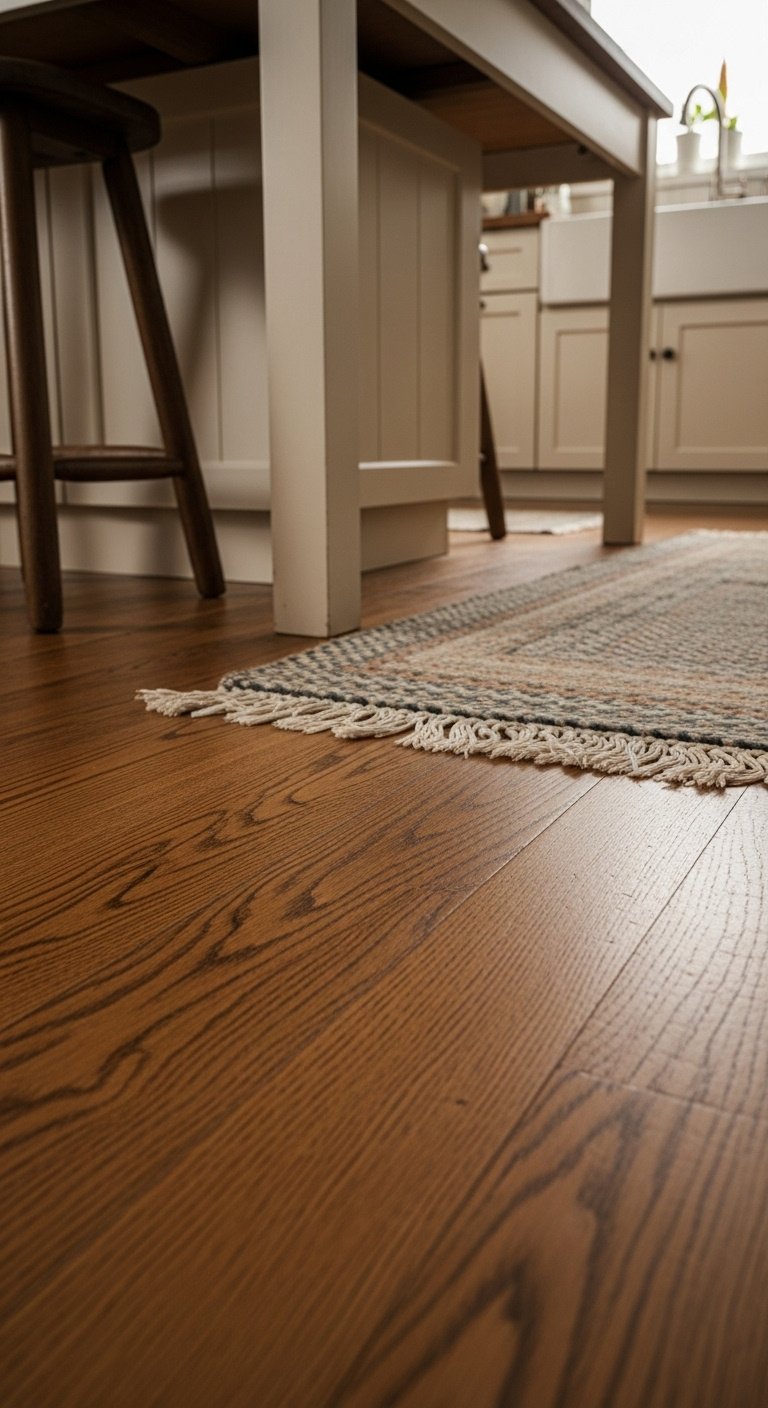
The flooring provides the literal foundation for your kitchen’s style, and hardwood is a timeless choice that adds immense warmth and character. Wood floors are a natural fit for the cottage aesthetic. A distressed or weathered finish is particularly fitting, as it adds a sense of history and imperfection that is central to the style’s charm.
While tile can also work, the natural warmth and grain of wood underfoot is hard to beat for creating that cozy, inviting feeling from the ground up. To add even more softness and color, layer a charming throw rug in front of the sink.
- Materials Needed: A small, charming throw rug (e.g., a vintage-style runner or a braided rug) and a rug pad.
- Step-by-Step Directions:
- Protect High-Traffic Areas: Hardwood floors are beautiful but they need protection in a high-use area like a kitchen. Place a durable runner in front of the sink and stove area, where spills and foot traffic are heaviest.
- Add Softness and Color: Choose a rug that complements your kitchen’s color scheme. A vintage-inspired floral or geometric pattern, or a simple, classic braided rug, adds an instant layer of cottage charm.
- Ensure Safety: This is crucial. Always place a non-slip rug pad underneath your rug to prevent it from moving around and creating a tripping hazard.
Pro Tip: If you are installing new hardwood floors, consider using wider planks for a more rustic, historic feel. From my experience, a matte or satin finish is far more forgiving than a high-gloss finish—it hides small scratches better and feels much more authentic to the classic cottage style.
Pin this timeless kitchen foundation idea!
13. Blend Old and New with Modern Touches

A truly timeless cottage kitchen is one that feels fresh and functional for modern life by thoughtfully blending old and new elements. You don’t have to live in the past to enjoy this aesthetic! The “modern cottage” style is about creating a balanced juxtaposition between classic charm and contemporary convenience.
This means you can have your charming beadboard cabinets and your sleek, modern appliances. The key is to make the integration seamless. Pair rustic wooden elements with clean, simple quartz countertops. Hang a minimalist pendant light over a vintage farmhouse table. This mix is what keeps the style feeling relevant and personal.
- Materials Needed: A modern element (e.g., a sleek faucet, minimalist pendant light, modern bar stools) and your existing vintage elements.
- Step-by-Step Directions:
- Start with a Cottage Base: Ensure the core elements that define the style—like cabinet details, soft colors, and natural textures—are firmly in place. This is your foundation.
- Introduce One Sleek Element: A great place to start is with the faucet. Swap out a traditional faucet for a modern, streamlined one in a finish like matte black or stainless steel. The contrast against a classic farmhouse sink can be stunning.
- Contrast Textures: Pair rough, rustic reclaimed wood shelves with a smooth, simple quartz or concrete countertop.
- Simplify Decor: Instead of filling every surface with many small vintage items, choose one or two larger, more impactful antique pieces and keep the surrounding surfaces clear and minimalist. This thoughtful balance is the secret to the modern cottage look.
Lesson Learned: The most successful modern cottage kitchens I’ve seen maintain a rough 80/20 balance. About 80% of the elements should be classic cottage (cabinets, colors, textiles), while 20% can be clean and modern (lighting, appliances, stools). This ratio ensures the space feels charmingly updated, not stylistically confused.
Get the best of both worlds! Save this modern cottage idea.
Key Takeaways: Your Quick Guide to a Cozy Cottage Kitchen
To quickly review, creating that coveted cozy cottage kitchen comes down to a few core principles. Focusing on these five areas will give you the biggest impact and help you build a kitchen you’ll love for years to come.
- Start with a Soft Palette: Use creamy whites, soft pastels, and muted earth tones as your foundation. This creates the light, airy, and welcoming base that is essential to the style.
- Embrace Natural Materials: Incorporate warm wood through countertops, flooring, or shelves. Use cozy, natural textiles like linen and cotton for curtains and cushions to add softness.
- Display Your Personality: Your kitchen should tell your story. Use open shelving and flea market finds to showcase collected dishware, beloved books, and unique decor that is meaningful to you.
- Prioritize Warm Lighting: Go beyond basic overhead lights. Layer multiple light sources, like pendants and sconces, and always install dimmer switches to create a warm, adjustable ambiance.
- Mix, Don’t Match: The ultimate charm of a cottage kitchen comes from its “collected-over-time” feel. Don’t be afraid to mix vintage pieces with new ones, or to pair different (but complementary) patterns and textures.
People Also Ask About Cozy Cottage Kitchens
How do I make my kitchen look like a cottage?
To make a kitchen look like a cottage, focus on key elements like soft colors, natural textures, and vintage details. Paint cabinets in soft colors like cream or sage green, install open shelving to display vintage dishes, use natural materials like wood countertops, and add cozy textiles like floral curtains or a braided rug. Incorporating a classic farmhouse sink and vintage-inspired lighting will beautifully complete the transformation.
What is the best kitchen color for a cottage?
The best colors for a cottage kitchen are soft, muted, and inspired by nature. Creamy whites, warm off-whites, and soft grays create a classic, airy base that maximizes light. For accent colors, pastels like soft blue, sage green, dusty pink, and buttery yellow are perfect choices for adding gentle color to cabinets or walls, enhancing the kitchen’s charming and inviting atmosphere.
What is a cottagecore kitchen?
A cottagecore kitchen is an aesthetic that idealizes a simple, rustic, and self-sufficient country lifestyle. It heavily features natural materials, abundant floral patterns, vintage and antique decor, and open shelving piled high with mismatched crockery. You’ll often see displays of handcrafted items, jars of preserves, and fresh-baked goods, as the focus is on creating a space that feels cozy, nostalgic, and deeply connected to nature and home-making activities.
How can I make my cottage kitchen cozy on a budget?
To create a cozy cottage kitchen on a budget, focus on high-impact, low-cost changes like paint and textiles. A fresh coat of a soft, warm color on walls or even just the cabinets can make a huge impact. Shop at thrift stores and flea markets for vintage dishes, art, and decor to add personality for pennies. Simple DIY projects like sewing cafe curtains or installing a peg rail for storage are also charming and inexpensive solutions.
Final Thoughts
Creating a cozy cottage kitchen isn’t about achieving picture-perfect flawlessness; it’s about building a warm, personal space that truly feels like the heart of your home. It’s a celebration of comfort, personality, and the beauty of everyday life. By thoughtfully layering in these timeless elements, you can design a kitchen that invites you to slow down, gather with the people you love, and enjoy the simple, happy moments.
Which of these cozy ideas will you be trying in your own kitchen first?
